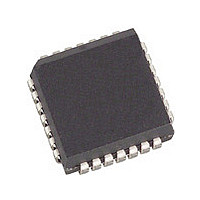PEEL22CV10AZJ-25L Diodes Zetex, PEEL22CV10AZJ-25L Datasheet - Page 3

PEEL22CV10AZJ-25L
Manufacturer Part Number
PEEL22CV10AZJ-25L
Description
Manufacturer
Diodes Zetex
Datasheet
1.PEEL22CV10AZJ-25L.pdf
(10 pages)
Specifications of PEEL22CV10AZJ-25L
Process Technology
EECMOS
# Macrocells
10
# I/os (max)
10
Propagation Delay Time
25ns
Operating Supply Voltage (typ)
5V
Operating Supply Voltage (min)
4.75V
Operating Supply Voltage (max)
5.25V
Operating Temp Range
0C to 70C
Operating Temperature Classification
Commercial
Mounting
Surface Mount
Pin Count
28
Lead Free Status / RoHS Status
Compliant
Anachip Corp.
www.anachip.com.tw
Function Description
The implements logic functions as sum-of-products expressions in
a programmable-AND/fixed-OR logic array. User-defined
functions are created by programming the connections of input
signals into the array. User-configurable output structures in the
form of I/O macrocells further increase logic flexibility.
Architecture Overview
The architecture is illustrated in the block diagram of Figure 19.
Twelve dedicated inputs and 10 I/Os provide up to 22 inputs and
10 outputs for creating logic functions (see Figure 21). At the
core of the device is a programmable electrically-erasable AND
array that drives a fixed OR array. With this structure, the
PEEL™22CV10AZ can implement up to 10 sum-of-products
logic expressions.
Associated with each of the ten OR functions is an I/O macrocell
that can be independently programmed to one of four different
configurations in standard 22V10 mode, or any one of 12 config-
urations using the special “Plus” mode. The programmable mac-
rocells allow each I/O to be used to create sequential or
combinatorial logic functions of active-high or active-low polar-
ity, while providing three different feedback paths into the AND
array.
AND/OR Logic Array
The programmable AND array of the PEEL™22CV10AZ
(shown in Figure 21) is formed by input lines intersecting prod- uct
terms. The input lines and product terms are used as follows:
At
EEPROM memory cell that determines whether or not there is a
logical connection at that intersection. Each product term is
essentially a 44-input AND gate. A product term that is con-
nected to both the true and complement of an input signal will
always be FALSE and therefore will not affect the OR function
that it drives. When all the connections on a product term are
opened, a “don’t care” state exists and that term will always be
TRUE.
When programming the PEEL™22CV10AZ, the device pro-
44 Input Lines:
– 24 input lines carry the true and complement of the signals
– 20 additional lines carry the true and complement values of
133 Product Terms:
– 120 product terms (arranged in 2 groups of 8, 10, 12, 14, and
– 10 output enable terms (one for each I/O)
– 1 global synchronous preset term
– 1 global asynchronous clear term
– 1 programmable clock term
each
16) are used to form sum of product functions
applied to the 12 input pins
feedback or input signals from the 10 I/Os
input-line/product-term intersection, there is an
available, contact Customer Service
contact factory for availability
3/10
grammer first performs a bulk erase to remove the previous pat-
tern. The erase cycle opens every logical connection in the array.
The device is configured to perform the user-defined function by
programming selected connections in the AND array. (Note that
PEEL™ device programmers automatically program all of the
connections on unused product terms so that they will have no
effect on the output function).
Variable Product Term Distribution
The PEEL™22CV10AZ provides 120 product terms to drive the
10 OR functions. These product terms are distributed among the
outputs in groups of 8, 10, 12, 14, and 16 to form logical sums
(see Figure 21). This distribution allows optimum use of the
device resources.
Programmable I/O Macrocell
The unique twelve-configuration output macrocell provides com-
plete control over the architecture of each output. The ability to
configure each output independently lets you to tailor the config-
uration of the PEEL™22CV10AZ to the precise requirements of
your design.
Macrocell Architecture
Each I/O macrocell, as shown in Figure 20, consists of a D-type
flip-flop and two signal-select multiplexers. The configuration of
the macrocell is determined by four EEPROM bits that control the
multiplexers. These bits determine the output polarity, output type
(registered or non-registered) and input-feedback path (bidi-
rectional I/O, combinatorial feedback). Refer to Table 1. for
details. Four of these macrocells duplicate the functionality of the
industry-standard PAL22V10. (See Figure 21 and Table 1.)
Figure 20 Block Diagram of the
PEEL™22CV10A I/O Macrocell
Rev. 1.0 Dec 16, 2004

















